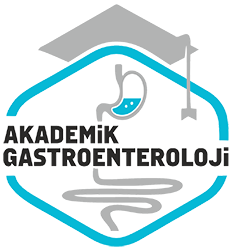Agustos 2023
Gastrointestinal nöroendokrin tümörlerde GLP-2 reseptör ekspresyonunun değerlendirilmesi
Evaluation of GLP-2 receptor expression in gastrointestinal neuroendocrine tumors
- Ana Sayfa
- Sayılar
- Agustos 2023
- Gastrointestinal nöroendokrin tümörlerde GLP-2 reseptör ekspresyonunun değerlendirilmesi...
Departments of 2Pathology and 3Gastroenterology, Dokuz Eylül University School of Medicine, Izmir
Özet
Giriş ve Amaç: Nöroendokrin tümörler, nöroendokrin sistem hücrelerinden kaynaklanir. Bu hücreler hem sinir hem de endokrin hücre özelligi gösterirler ve vücuttaki birçok organda bulunabilirler. GLP-1 ve GLP-2, gida alimini takiben 1:1 oraninda bağırsak L hücrelerinden salinir. GLP-2 reseptörü, GLP-2’yi tanır. GLP-2 reseptör mRNA transkriptleri mide, ince ve kalin bağırsak, beyin ve akcigerde tespit edilmıştır. GLP-2’nin proliferatif etkisi farelerde, siçanlarda, domuzlarda ve insanlarda eksojen GLP-2 uygulanarak gösterilmıştır. Amaç, gastroenteropankreatik nöroendokrin tümörler ile glukagon benzeri peptid-2 ve GLP-2 reseptör arasındaki ilişkiyi değerlendirmektir. Gereç ve Yöntem: 2006-2009 yıllari arasında patolojik olarak gastroenteropankreatik nöroendokrin tümör tanısı alan hastalar çalışmaya dahil edildi. çalışmaya 47 hasta (27 kadın, 20 erkek, ortalama yaş: 54 ± 15.5) alındı. Ayrıca 46 kontrol grubu hastası (25 kadın, 21 erkek, ortalama yaş: 57.5 ± 14.8) vardı. Poli-L-lisin mikroskop lamlarinda hazirlanan patolojik doku bloklari, GLP-2 reseptör antikoru (1:100 - 1:200, 1 mg/ml) immünohisto kimyasal boyama ile boyandi. Bulgular: Kolon nöroendokrin tümör grubunun GLP-2 reseptör pozitifliği %30 (4/13), kolon kontrol grubunun GLP-2 reseptör pozitifliği %100 bulundu. Pankreas nöroendokrin tümör grubunun GLP-2 reseptör pozitifliği %25 (3/12) iken, pankreas kontrol grubunda %100 idi. Kolon nöroendokrin tümör ile kontrol grubunun karsilastirilmasinda anlamli farklilik görüldü (p: 0.003). Pankreas nöroendokrin tümör ile kontrol grubunun karsilastirilmasi da istatistiksel olarak anlamli farklilik gösterdi (p < 0.001). Gastrik nöroendokrin tümörlerin kontrol ile karsilastirilmasi karsilastirilabilir sonuçlar verdi (p: 0.22). Sonuç: GLP-2 reseptörünün bu tümörlerin tanı ve tedavisinde somatostatin reseptörleri kadar yararli olamayacagi sonucuna vardık. Bu konuda farkli yöntemlerle daha fazla çalışmaya ihtiyaç vardır
Abstract
Background and Aims: Neuroendocrine tumors arise from cells of the neuroendocrine system. These cells show both nerve and endocrine cell characteristics and can be found in many organs in the body. GLP-1 and GLP-2 are released from intestinal L cells in a 1:1 ratio following food intake. GLP-2 receptor recognizes GLP-2. GLP-2 receptor mRNA transcripts have been detected in the stomach, small and large intestine, brain, and lung. The proliferative effect of GLP-2 has been demonstrated in mice, rats, pigs, and humans by administering exogenous GLP-2. The objective is to evalaute the relation between gastroenteropancreatic neuroendocrine tumors and glukagon like peptid-2 and GLP-2 receptor. Materials and Methods: The patients, who were pathologically diagnosed with gastroenteropancreatic neuroendocrine tumor between 2006-2009 were included in the study. There were 47 patients (27 females, 20 males, avarage age: 54 ± 15.5) in the study. There were also 46 control group patients (25 females, 21 males, avarage age: 57.5 ± 14.8). Pathological tissue blocks prepared on poly-L-lysine microscope slides were stained by GLP-2 receptor antibody (1:100 - 1:200, 1 mg/ml) immunohistochemical stain. Results: GLP-2 receptor positivity of colon neuroendocrine tumor group was 30% (4/13) and colon control group was %100. GLP-2 receptor positivity of pancreas neuroendocrine tumor group was 25% (3/12) while it was 100% in pancreas control group. The comparison of colon neuroendocrine tumor and control group showed significant difference (p: 0.003). The comparison of pancreas neuroendocrine tumor and control group also showed statistically significant difference (p < 0.001). The comparison of gastric neuroendocrine tumor with the control yielded comparable results (p: 0.22). Conclusions: We concluded that GLP-2 receptor cannot be as useful as somatostatin receptors in diagnosis and treatment of these tumors. More studies are needed on this subject with different methods.



